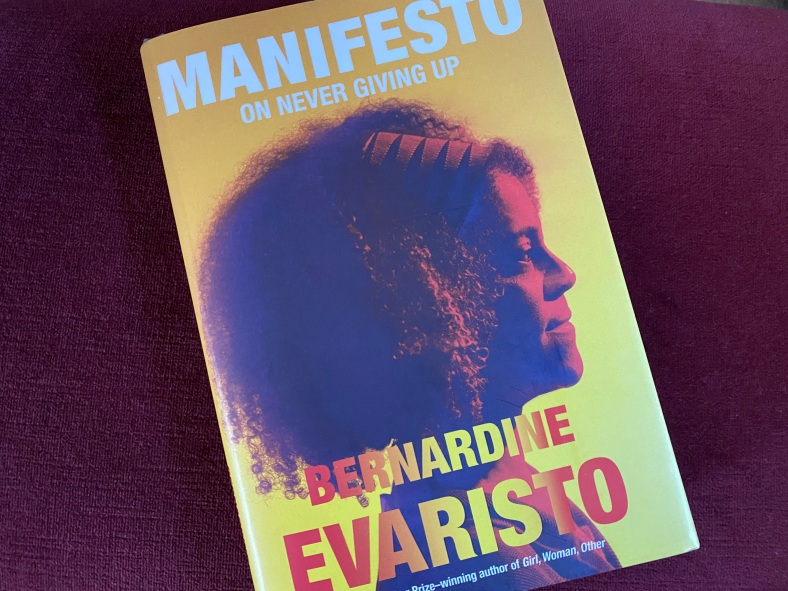“I was never prepared to settle for less than I desired.”
I sometimes think our investment in professional development is better made on novels and memoirs vs. management guides. If you agree, head to your local independent bookstore for a copy of author Bernardine Evaristo’s ‘Manifesto’. (You may add an underlining marker to your purchase as well – take notes!) This memoir by the Booker Prize winning author follows her life and career trajectory and in doing so, describes influences, struggles, priorities, commitment, and the value of life-long learning.
She begins with a question: “Most people in the arts have role models –writers, artists, creatives – who have inspired them, but what are the other elements that lay the foundation for our creativity and steer the direction of our careers?”
How do you find a path to success when you don’t have access to the resources of the elite? How do you move beyond “My school didn’t inspire me to greatness… Nobody encouraged us to think big and make our dreams come true.”?
In seven chapters, Ms. Evaristo details the evolution of her work ethic, commitment to craft and determination to mentor those who follow. Her story is a lived example of the value and responsibility of experience. Her narrative is relevant because each reader will find a point of connection in following the writer’s journey.
“… we all learn, eventually that life demands a lot more from us than the ability to get good grades. Combating struggle and disappointment early on in life can instill a strength and determination we would not otherwise possess… Life presents us with obstacles. It’s never a completely smooth ride for anyone, and while nobody wants to struggle, it’s the only way to build resilience.”
And we don’t stop learning. “My goal, as always, is to continue to write stories and to develop my skills. There is no point of arrival whereby one stops growing as a creative person; to think otherwise will lead to creative repetition and stagnation.”
We read memoirs because we are curious. At the center, who is this person?
“I am first and foremost a writer; the written word is how I process everything – myself, life, society, history, politics. It’s not just a job or a passion, but it is at the very heart of how I exist in the world, and I am addicted to the adventure of storytelling as my most powerful means of communication.”
But that’s only part of the story. In her book review for NPR, writer Hope Wabuke described the ‘real world’ impact of Ms. Evaristo’s commitment and influence. “Evaristo’s work in supporting inclusivity in the literary arts is legend. It includes the commission of a Free Verse report, which found that less than 1% of poetry books in the United Kingdom were published by poets of color, and then creating a mentorship program, The Complete Works, to do something about it; this program mentored 30 poets over two years. Evaristo’s advocacy work also created the Brunel Poetry Prize for African writers, the first and largest award of its kind, and led her to work alongside Kwame Dawes in situating the African Poetry Book Fund as a force that has changed the shape of contemporary publishing. Most recently, as the curator of Black Britain: Writing Black, Evaristo is republishing overlooked books by Black authors such as Minty Alley, by C.L.R James originally published in 1936.”
‘Manifesto’ is one more creative endeavor for Ms. Evaristo to share her wisdom. Not all influences are one-on-one connections. Sometimes we find direction in a book.
“We must pass on what we know to the next generation, & express gratitude to those who help us – nobody gets anywhere on their own.”
Learn more:
Bernardine Evaristo books – https://bevaristo.com/books/
Black Britain: Writing Back – https://www.theguardian.com/books/2021/jan/09/booker-winners-mission-to-put-uks-forgotten-black-writers-back-in-print
Brunel African Poetry Prize – https://www.africanpoetryprize.org
An aside: I picked up two new applicable concepts: “period of self-calibration” (which we can all use about now) and “to bounce back in the act of falling.” (advice to her students to continue to be positive)








 The book is a ‘behind the scenes’ look at the development of a musical. It’s a narrative of the creative process and a roadmap for future generations who will replicate the production on high school and summer stages.
The book is a ‘behind the scenes’ look at the development of a musical. It’s a narrative of the creative process and a roadmap for future generations who will replicate the production on high school and summer stages. We learn from the wisdom of others. ‘Hamilton The Revolution’ introduces us to a serious set of theater luminaries and traces each of their stories as the words and music evolve.
We learn from the wisdom of others. ‘Hamilton The Revolution’ introduces us to a serious set of theater luminaries and traces each of their stories as the words and music evolve.



